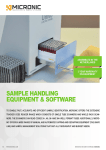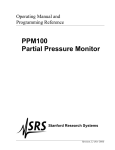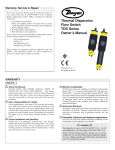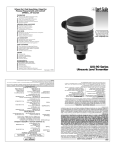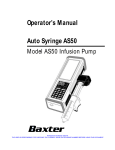Download Omega LTU-101 Riding Toy User Manual
Transcript
MAD IN USA WARRANTY / DISCLAIMER OMEGA ENGINEERING, INC. warrants this unit to be free of defects in materials and workmanship for a period of 13 months from date of purchase. OMEGA’s Warranty adds an additional one (1) month grace period to the normal one (1) year product warranty to cover handling and shipping time. This ensures that OMEGA’s customers receive maximum coverage on each product. If the unit malfunctions, it must be returned to the factory for evaluation. OMEGA’s Customer Service Department will issue an Authorized Return (AR) number immediately upon phone or written request. Upon examination by OMEGA, if the unit is found to be defective, it will be repaired or replaced at no charge. OMEGA’s WARRANTY does not apply to defects resulting from any action of the purchaser, including but not limited to mishandling, improper interfacing, operation outside of design limits, improper repair, or unauthorized modification. This WARRANTY is VOID if the unit shows evidence of having been tampered with or shows evidence of having been damaged as a result of excessive corrosion; or current, heat, moisture or vibration; improper specification; misapplication; misuse or other operating conditions outside of OMEGA’s control. Components which wear are not warranted, including but not limited to contact points, fuses, and triacs. OMEGA is pleased to offer suggestions on the use of its various products. However, OMEGA neither assumes responsibility for any omissions or errors nor assumes liability for any damages that result from the use of its products in accordance with information provided by OMEGA, either verbal or written. OMEGA warrants only that the parts manufactured by it will be as specified and free of defects. OMEGA MAKES NO OTHER WARRANTIES OR REPRESENTATIONS OF ANY KIND WHATSOEVER, EXPRESS OR IMPLIED, EXCEPT THAT OF TITLE, AND ALL IMPLIED WARRANTIES INCLUDING ANY WARRANTY OF MERCHANTABILITY AND FITNESS FOR A PARTICULAR PURPOSE ARE HEREBY DISCLAIMED. LIMITATION OF LIABILITY: The remedies of purchaser set forth herein are exclusive, and the total liability of OMEGA with respect to this order, whether based on contract, warranty, negligence, indemnification, strict liability or otherwise, shall not exceed the purchase price of the component upon which liability is based. In no event shall OMEGA be liable for consequential, incidental or special damages. CONDITIONS: Equipment sold by OMEGA is not intended to be used, nor shall it be used: (1) as a “Basic Component” under 10 CFR 21 (NRC), used in or with any nuclear installation or activity; or (2) in medical applications or used on humans. Should any Product(s) be used in or with any nuclear installation or activity, medical application, used on humans, or misused in any way, OMEGA assumes no responsibility as set forth in our basic WARRANTY/ DISCLAIMER language, and, additionally, purchaser will indemnify OMEGA and hold OMEGA harmless from any liability or damage whatsoever arising out of the use of the Product(s) in such a manner. RETURN REQUESTS / INQUIRIES Direct all warranty and repair requests/inquiries to the OMEGA Customer Service Department. BEFORE RETURNING ANY PRODUCT(S) TO OMEGA, PURCHASER MUST OBTAIN AN AUTHORIZED RETURN (AR) NUMBER FROM OMEGA’S CUSTOMER SERVICE DEPARTMENT (IN ORDER TO AVOID PROCESSING DELAYS). The assigned AR number should then be marked on the outside of the return package and on any correspondence. The purchaser is responsible for shipping charges, freight, insurance and proper packaging to prevent breakage in transit. FOR NON-WARRANTY REPAIRS, consult FOR WARRANTY RETURNS, please have the OMEGA for current repair charges. Have the folfollowing information available BEFORE contacting lowing information available BEFORE contacting OMEGA: OMEGA: 1. Purchase Order number under which the product 1. Purchase Order number to cover the COST was PURCHASED, of the repair, 2. Model and serial number of the product under 2. Model and serial number of the product, and warranty, and 3. Repair instructions and/or specific problems 3. Repair instructions and/or specific problems relative to the product. relative to the product. omega.com ® ® OMEGAnet ® On-Line Service www.omega.com Internet e-mail [email protected] Servicing North America: Canada: 976 Bergar Laval (Quebec) H7L 5A1, Canada Tel: (514) 856-6928 FAX: (514) 856-6886 e-mail: [email protected] USA: ISO 9001 Certified One Omega Drive, Box 4047 Stamford CT 06907-0047 Tel: (203) 359-1660 FAX: (203) 359-7700 e-mail: [email protected] For immediate technical or application assistance: USA and Canada: Sales Service: 1-800-826-6342 / 1-800-TC-OMEGA® Customer Service: 1-800-622-2378 / 1-800-622-BEST ® Engineering Service: 1-800-872-9436 / 1-800-USA-WHEN® TELEX: 996404 EASYLINK: 62968934 CABLE: OMEGA Mexico: ~ol: (001) 203-359-7803 En Espan FAX: (001) 203-359-7807 e-mail: [email protected] [email protected] Servicing Europe: United Kingdom: ISO 9002 Certified Frystatska 184/46, 733 01 Karvina´, Czech Republic Tel: +420 (0)59 6311899 FAX: +420 (0)59 6311114 Toll Free: 0800-1-66342 e-mail: [email protected] Daimlerstrasse 26, D-75392 Deckenpfronn, Germany Tel: +49 (0)7056 9398-0 FAX: +49 (0)7056 9398-29 Toll Free in Germany: 0800 639 7678 e-mail: [email protected] Postbus 8034, 1180 LA Amstelveen The Netherlands Tel: +31 (0)20 3472121 FAX: +31 (0)20 6434643 Toll Free in Benelux: 0800 0993344 e-mail: [email protected] Germany/Austria: Benelux: Czech Republic: One Omega Drive River Bend Technology Centre Northbank, Irlam Manchester M44 5BD United Kingdom Tel: +44 (0)161 777 6611 FAX: +44 (0)161 777 6622 France: 11, rue Jacques Cartier 78280 Guyancourt, France Tel: +33 (0)1 61 37 29 00 FAX: +33 (0)1 30 57 54 27 Toll Free in France: 0800 466 342 e-mail: [email protected] Toll Free in United Kingdom: 0800-488-488 e-mail: [email protected] It is the policy of OMEGA to comply with all worldwide safety and EMC/EMI regulations that apply. OMEGA is constantly pursuing certification of its products to the European New Approach Directives. OMEGA will add the CE mark to every appropriate device upon certification. The information contained in this document is believed to be correct, but OMEGA Engineering, Inc. accepts no liability for any errors it contains, and reserves the right to alter specifications without notice. WARNING: These products are not designed for use in, and should not be used for, human applications. Metering & Control Instrumentation Refractometers Pumps & Tubing Air, Soil & Water Monitors Industrial Water & Wastewater Treatment pH, Conductivity & Dissolved Oxygen Instruments OMEGA’s policy is to make running changes, not model changes, whenever an improvement is possible. This affords our customers the latest in technology and engineering. OMEGA is a registered trademark of OMEGA ENGINEERING, INC. © Copyright 2003 OMEGA ENGINEERING, INC. All rights reserved. This document may not be copied, photocopied, reproduced, translated, or reduced to any electronic medium or machine-readable form, in whole or in part, without the prior written consent of OMEGA ENGINEERING, INC. 䡺 ⻬ 䡺 ⻬ 䡺 ⻬ 䡺 ⻬ 䡺 ⻬ 䡺 ⻬ M-3949/0403 Powered Level Switch ENVIRONMENTAL MONITORING AND CONTROL 䡺 ⻬ 䡺 ⻬ 䡺 ⻬ 䡺 ⻬ 䡺 ⻬ LTU-101, LVU-150, LVC-152 LVC-100 & LVF-210 Series Heating Cable Cartridge & Strip Heaters Immersion & Band Heaters Flexible Heaters Laboratory Heaters NRTL/C HEATERS 䡺 ⻬ 䡺 ⻬ 䡺 ⻬ 䡺 ⻬ 䡺 ⻬ Data Acquisition & Engineering Software Communications-Based Acquisition Systems Plug-in Cards for Apple, IBM & Compatibles Datalogging Systems Recorders, Printers & Plotters DATA ACQUISITION 䡺 ⻬ 䡺 ⻬ 䡺 ⻬ 䡺 ⻬ IP 68 pH Electrodes, Testers & Accessories Benchtop/Laboratory Meters Controllers, Calibrators, Simulators & Pumps Industrial pH & Conductivity Equipment pH/CONDUCTIVITY 䡺 ⻬ 䡺 ⻬ 䡺 ⻬ 䡺 ⻬ http://www.omega.com e-mail: [email protected] Rotameters, Gas Mass Flowmeters & Flow Computers Air Velocity Indicators Turbine/Paddlewheel Systems Totalizers & Batch Controllers FLOW/LEVEL 䡺 ⻬ 䡺 ⻬ 䡺 ⻬ 䡺 ⻬ “ Transducers & Strain Gauges Load Cells & Pressure Gauges Displacement Transducers Instrumentation & Accessories PRESSURE, STRAIN AND FORCE 䡺 ⻬ Thermocouple, RTD & Thermistor Probes, Connectors, Panels & Assemblies 䡺 ⻬ Wire: Thermocouple, RTD & Thermistor 䡺 ⻬ Calibrators & Ice Point References 䡺 ⻬ Recorders, Controllers & Process Monitors 䡺 ⻬ Infrared Pyrometers TEMPERATURE Where Do I Find Everything I Need for Process Measurement and Control? OMEGA…Of Course! User’s Guide SPECIFICATIONS Step One Contact output: Process temp.: Pressure: Sensor rating: Cable type: Cable length: Process mount: Mount. gasket: Classification: CE compliance: Universal ± 1 mm in water ± 0.5 mm in water 12-36 VDC 25 mA maximum (1) SPST relay GP: 120 VAC/VDC @ 1A (CE: 60 VAC/VDC @ 1A) Selectable NO/NC F: -40˚ to 194˚ C: -40˚ to 90˚ 150 psi (10 bar) @ 25˚ C., derated @ 1.667 psi (.113 bar) per ˚C. above 25˚ C. NEMA 6 (IP68) 4-conductor, #22 AWG (shielded) Standard: 10' (3m) 3/4" NPT (3/4" G / Rp) Viton® (G version only) General purpose EN 50082-2 immunity EN 55011 emission EN 61010-1 safety Sensor material: PP-Ryton® (glass fill) Cable jacket mat.: PP LVU-150 series Specifications: Sensor material: -150/-152: PP -151/-153: PFA Cable jacket mat.: -150/-152: PP -151/-153: PFA Operating Pressure (psi) Orientation: Accuracy: Repeatability: Supply voltage: Consumption: Contact type: Contact rating: Pressure / Temperature Derating LTU-101 series Specifications: 160 Unacceptable 140 Range 120 100 80 Acceptable 60 Range 40 20 00 -40 -20 00 LVC-100 series Specifications: Dielectric range: > 20 constants Conductive range: > 100 micromhos Sensor material: -101/-103: PP -102/-104: PFA Cable jacket mat.: -101/-103: PP -102/-104: PFA LVC-152 series Specifications: Dielectric range: Conductive range: Sensor material: Cable jacket mat.: > 20 constants > 100 micromhos PP PP 20 40 60 80 100 Temperature (¡C) Ambient Sensor Temperature (¡C) Common Specifications: Maximum Tem. / Voltage Derating Continuous 20 mA Sinking Curve 100 Unacceptable 80 Range 60 40 Acceptable Range 20 00 -20 12 16 20 24 28 32 36 Operating Voltage (VDC) LVF-210 series Specifications: 4-20 mA Sensor Max. Series Resistance (Ohms) Sensor material: -210/-212: PP -211/-213: PFA Cable jacket mat.: -210/-212: PP -211/-213: PFA Electrical Loading Limits 1,600 1,400 1,200 1,000 Unacceptable Range 800 600 Acceptable 400 Range 200 0 12 18 24 30 36 Supply Voltage (VDC) Table of Common Dielectric Constants NOTE: Liquids with a dielectric constant less than 20 will not be detected by an LVC-152 series or LVC-100 series level switch, as factory calibrated. Acetone 21 Acetoaldehyde 22.2 Acetyl methyl hexyl ketone 28 Alcohol 16 to 31 Ammonia 15 to 25 Acetic acid 4.1 to 6.2 Butyl chloride 9.6 Barium chloride 9 to 11 Benzene 2.3 Benzine 2.3 Barium nitrate 5.6 Bromine 3.1 Chlorobenzene 4.7 to 6 Chlorotoluene 4.7 Chloroform 4.5 to 5.0 Chlorine, liquid 2.0 Carbon tetrachloride 2.2 Cyan 2.6 Cyclohexane methanol 3.7 D.I. Water 20 Ethyl toluene 2.2 Ethyl alcohol 23 Ethylene glycol 37 Ethylene oxide 14 Ethylene dichloride 11 to 17 Ethylene chloride 10.5 Ethyl acetate 6.4 Ethyl salicylate 8.6 Ethyl stearate 2.9 Ethyl silicote 4.1 Formic acid 59 Ferric oleate 2.6 Freon 2.2 Glycerine 47 Glycol 30 Glycol nitrite 27 Gasoline 2 to 2.2 Hydrochloric acid 4.6 Isobutyric acid 2.7 Isobutyl methyl ketone 13 Jet fuel 1.7 Lead carbonate 18 Lead nitrate 38 Methyl salicylate 9.0 Methanol 33 Methyl alcohol 33 to 38 Margarine, liquid 2.8 to 3.2 Methyl acetate 7.3 N-butyl formate 2.4 Nitrobenzene 26 to 35 Nitrotoluene 25 Naphthalene 2.3 to 2.5 Oils, vegetable2.5 to 3.5 Oils, mineral 2.3 to 2.4 Oils, petroleum 1.8 to 2.2 Oleic acid 2.5 Propane, liquid 1.8 to 1.9 Potassium nitrate 5.0 to 5.9 Potassium chloride 5.0 Stearic acid 2.3 Toluene 2.4 Trichloroethylene 3.4 Trichloroacetic acid 4.5 Terephthalic acid 1.5 to 1.7 Thinner 3.7 Urea 3.5 Vinyl chloride 2.8 to 6 Vinyl alcohol 1.8 to 2.0 Water, 20°C 80 Water, 100°C 48 DIMENSIONS Step Two Vibration Level Switch, LTU-101 series 0.7" 3/4" NPT (3/4" G) 10’ Cable (3m) (18mm) 3/4" NPT (3/4" Rp) 2.3" (57mm) 3.0" (76mm) 4.7" (120mm) Ultrasonic Level Switch, LVU-150 series 3/4" NPT (3/4" G) 10’ Cable (3m) 3/4" NPT (3/4" Rp) 0.7" (19mm) 0.7" 3/4" NPT (3/4" Rp) (19mm) 3/4" NPT (3/4" Rp) 10’ Cable (3m) 2.1" (54mm) 2.8" (71mm) 0.7" (19mm) 1.3" (32mm) 4.5" (114mm) 3.0" (76mm) SuperGuard RF Capacitance Level Switch, LVC-152 series 10’ Cable (3m) (19mm) 3/4" NPT (3/4" G) 0.7" 3/4" NPT (3/4" Rp) 2.6" (67mm) 3.3" (83mm) 5.0" (127mm) Intrusive RF Capacitance Level Switch, LVC-100 series 3/4" NPT (3/4" G) 10’ Cable (3m) 3/4" NPT (3/4" Rp) 0.7" (19mm) 0.7" 3/4" NPT (3/4" Rp) (19mm) 3/4" NPT (3/4" Rp) 10’ Cable (3m) 2.1" (54mm) 2.8" (70mm) 0.7" (19mm) 1.3" (32mm) 4.5" (114mm) 3.0" (76mm) Optic Leak Detection Switch, LVF-210 series 3/4" NPT (3/4" Rp) 3/4" NPT (3/4" G) 3/4" NPT (3/4" Rp) 10’ Cable (3m) 2.1" (54mm) 2.8" (71mm) 4.5" (114mm) * all dimensions are Nominal 0.7" 0.7" (19mm) (19mm) 3/4" NPT (3/4" Rp) 10’ Cable (3m) 0.7" (19mm) 1.3" (32mm) 3.0" (76mm) SAFETY PRECAUTIONS Step Three INTRODUCTION Step Four About this Manual: Vibration Switch: PLEASE READ THE ENTIRE MANUAL PRIOR TO INSTALLING OR USING THIS PRODUCT. This manual includes information on all models of Omega’s powered level switches: LTU-101 series, LVU-150 series, LVC-152 series, LVC100 series and LVF-210 series. Please refer to the part number located on the switch label to verify the exact model which you have purchased. The Tuning Fork vibration switch operates at a nominal frequency of 400 Hz. As the switch becomes immersed in a liquid or slurry, a corresponding frequency shift occurs. When the measured frequency shift reaches the set point value, the switch changes state indicating the presence of a liquid or slurry medium. User’s Responsibility for Safety: Omega manufactures a wide range of liquid level sensors and technologies. While each of these sensors is designed to operate in a wide variety of applications, it is the user’s responsibility to select a sensor model that is appropriate for the application, install it properly, perform tests of the installed system, and maintain all components. The failure to do so could result in property damage or serious injury. Proper Installation and Handling: Because this is an electrically operated device, only properlytrained staff should install and/or repair this product. Use a proper sealant with all installations. Never overtighten the sensor within the fitting, beyond a maximum of 80 inch-pounds torque. Always check for leaks prior to system start-up. Material Compatibility: The LVU-150, LVC-100 and LVF-210 series sensors are available in two different wetted materials. Models LVU-150/-152, LVC101/-103 and LVF-210/-212 are made of Polypropylene(PP). Models LVU-151/-153, LVC-102/-104 and LVF-211/-213 are made of Perfluoroalkoxy(PFA), also known by the trade name Teflon. The LTU-101 series is made of PP with the forks made of Ryton (40% glass filled) and the LVC-152 series is made of PP. Make sure that the model you have selected is compatible with the application liquid. To determine the chemical compatibility between the sensor and its application liquids, refer to an industry reference. Wiring and Electrical: The supply voltage used to power the sensor should never exceed a maximum of 36 volts DC. Electrical wiring of the sensor should be performed in accordance with all applicable national, state, and local codes. Flammable, Explosive and Hazardous Applications: DO NOT USE THE LTU-101, LVU-150, LVC-152, LVC-100 OR LVF-210 SERIES GENERAL PURPOSE SWITCH IN HAZARDOUS LOCATIONS. WARNING The rating for the relay is 120 VAC/60 VDC @ 1A. For CE rated applications, the relay rating is 60 VAC/60 VDC @ 1A. Omega’s powered level switches are not recommended for use with electrically charged application liquids. For most reliable operation, the liquid being measured may need to be electrically grounded. Do not squeeze the forks together. Doing so could damage or break the sensor and void the warranty. When powering up the LTU-101 series, the start-up procedure requires the switch to cycle through a wet condition for 1/2 second in order to determine an initial resonance. Ultrasonic Switch: The Ultrasonic level switch generates a 1.5 MHz ultrasonic wave from a miniature piezoelectric transducer located on one side of the gap in its sensing tip. Another piezo transducer located on the other side of the gap acts as a microphone, picking up the sound. When liquid enters the gap in the sensing tip, the audio level changes. The sensor should be installed so that the liquid will drip out of the gap when the sensor becomes dry. Optic Switch: The Optic Leak Detector use principles of optical refraction to detect the presence or absence of fluid. A pulsed infrared light beam is internally generated by a light emitting diode and aimed at the slanted optical tip of the sensor. If the tip is dry, the light beam bounces at a 90 degree angle to a receiving photo transistor, indicating a dry condition. If the tip is immersed in liquid, the light beam will refract out into the liquid instead of being reflected to the photo transistor, indicating a wet condition. The Optic Leak Detector can not detect the presence or absence of specular application liquids that reflect light (such as milk), or viscous liquids (such as paint) that form a coating on the sensor tip. SuperGuard Capacitance Switch: The SuperGuard level switch generates a pulse-wave radio frequency signal from the capacitance electrode located in the sensing tip of each sensor. When liquid comes into contact with the sensing tip, the capacitance as measured by the sensor changes based on the dielectric constant of the liquid. The guard circuit rejects the negative effects of coating buildup on the probe by eliminating the coating signal path between the active and reference electrodes. Intrusive RF Capacitance Switch: The Intrusive RF Capacitance level switch generates a 300 kHz pulsewave radio frequency signal from the capacitance electrode located in the sensing tip of each sensor. When liquid comes into contact with the sensing tip, the capacitance as measured by the sensor changes based on the dielectric constant of the liquid. The sensor’s operation may vary based on the dielectric properties of various application liquids. The LVC-152 series & LVC-100 series sensor is factory-calibrated to be used with liquids with a dielectric value between 20 and 80. Liquids with a dielectric constant less than 20 will not be detected by an LVC-152 series & LVC-100 series sensor, as factory calibrated. INSTALLATION ELECTRICAL Step Five Step Six Through Wall Installation: Supply Voltage: The supply voltage to the powered level switch should never exceed a maximum of 36 VDC. Omega controllers have a built-in 13.5 VDC power supply which provides power to all of Omega’s electrically powered sensors. Alternative controllers and power supplies, with a minimum output of 12 VDC up to a maximum output of 36 VDC, may also be used with the powered level switch. Omega’s powered level switches may be installed through the top, side or bottom of a tank wall. The sensor has male 3/4" NPT threads on either side of a 15/16" wrench flat. This enables the user to select the sensor’s mounting orientation, installed outside of the tank in, or inside of the tank out. Required Cable Length: Determine the length of cable required between the powered level switch and its point of termination. Allow enough slack to ensure the easy installation, removal and/or maintenance of the sensor. The cable length may be extended up to a maximum of 1000 feet, using a well-insulated, 14 to 20 gauge shielded four conductor cable. Multi-Point Installation: Omega’s LVM-10 series mounting system is an in-tank fitting which enables users to install up to four OMEGA sensors of any technology, to any depth, along the entire length of track. LVM-10 series may be installed through the top wall of any tank using a standard 2" NPT tank adapter. If no tank top installation is available, Omega's side mount bracket, LVM-30, enables LVM-10 series to be installed directly to the side wall of a tank. Wire Stripping: Using a 10 gauge wire stripper, carefully remove the outer layer of insulation from the last 1-1/4" of the sensor's cable. Unwrap and discard the exposed foil shield from around the signal wires, leaving the drain wire attached if desired. With a 20 gauge wire stripper, remove the last 1/4" of the colored insulation from the signal wires. Signal Outputs (Current sensing): The standard method used by Omega controllers; this technology uses only two wires (Red and Black). The sensor draws 5 mA when it is dry, and 19 mA when wet. NC/NO status must be set by the controller. The White and Green wires are not used. Single-Point Installation: Red Omega’s LVM-50 series mounting system is an in-tank fitting which enables users to install one OMEGA sensor, of any technology, to a specific depth. The Omega sensor may be installed onto the 3/4" NPT adapter at the end of the LVM-50 series. LVM-50 series may be installed through the top wall of any tank using a standard 2" NPT tank adapter. Omega's side mount bracket, model LVM-30, may also be used if top wall installation is not available. Junction Box 2" Coupling + - Shield Ground Black + 24 VDC Power Supply Multimeter (mA) Signal Output (Relay switching): Allows the sensor to switch a small load on or off directly, using an internal 1A relay (60 VAC/60 VDC). Omega’s powered level switches features 4 wires (red, black, white and green) and a shield wire. The NO/NC status is set by the polarity of the voltage feeding the red and black wires. The green wire is the common for the relay and the white wire is the NO or NC, depending on the polarity of red and black. Normally Open Wiring: LVM-50 Red Series Black High Level Sensor Shield Ground White Green LVM-10 + + 24 VDC Power Supply Multimeter (Continuity) Series Normally Open Wiring: Black Low Level Sensor Red Shield Ground White Green + + 24 VDC Power Supply Multimeter (Continuity) WIRING WIRING Step Eight Wiring to a Omega Controller: Wiring the Relay Output: LVCN-110 Series Controller (4 or 20 mA signal output) The relay output can be wired as a dry contact to a VDC or VAC power source. Powered level switch does require 12 - 36 VDC power to operate the sensor and switch the relay. All illustrations below identify a Dry switch state as the normal position of the relay. NC NO 115 VAC 220 VAC DELAY LCVN-120/-130/-140 Series Controller (4 or 20 mA signal output) P OWER I N V E R T D E L AY -- + INVERT D E L AY (-) Red C Black R Green* - Not Used (+) GND White - Not Used AC Shld - Not Used AC P INVERT +/- P IN T U 1 Step Seven Switching a Normally Open DC Load: The Red wire connects to Positive (+) of the power supply and the Black wire connects to Negative (-). The LOAD can be attached to either the Green or White wires. Complete the circuit by either connecting the Green to (+) VDC power or White to (-) VDC power (see illustration below). [Dry Condition] Sensor (NO) -- + R E L AY 1 R E L AY 2 RED GRN SHLD WHT BLK [+] LOAD OR LOAD [-] L AT C H INPUT1 INPUT2A Red Black Shld Not Used - White Not Used - Green* ONOFF INPUT2B Switching a Normally Closed DC Load: The Black wire connects to Positive (+) of the power supply and the Red wire connects to Negative (-). The LOAD can be attached to either the Green or White wires. Complete the circuit by either connecting the Green to (+) VDC power or White to (-) VDC power (see illustration below). [Dry Condition] Sensor (NC) BLK GRN SHLD WHT RED [+] LOAD OR LOAD [-] Switching a Normally Open AC Load: The Red wire connects to Positive (+) of the DC power supply and the Black wire connects to Negative (-). The LOAD can be attached to the Green wire and the Hot of the VAC power. Connect the White to the Neutral of the VAC power (see illustration below). [Dry Condition] Sensor (NO) RED GRN SHLD WHT BLK [+] LOAD [AC Power] [-] Switching a Normally Closed AC Load: The Black wire connects to Positive (+) of the DC power supply and the Red wire connects to Negative (-). The LOAD can be attached to the Green wire and the Hot of the VAC power. Connect the White to the Neutral of the VAC power (see illustration below). [Dry Condition] Sensor (NC) BLK GRN SHLD WHT RED [+] LOAD [AC Power] [-] WIRING MAINTENANCE Step Nine Step Ten Wiring as a P-Channel or N-Channel output: General: The powered level switch can be substituted for either a P-Channel (PNP, sourcing) output or a N-Channel (NPN, sinking) output. The powered level switch requires no periodic maintenance except cleaning as required. It is the responsibility of the user to determine the appropriate maintenance schedule, based on the specific characteristics of the application liquids. Normally Open DC Load as a P-Channel Output: To wire as a NO P-Channel output, follow the directions below. The Red wire connects to Positive (+) of the power supply and the Black wire connects to Negative (-). The Green wire is jumpered to the Red wire while the White wire is connected to the LOAD. Jumper the LOAD back to the Negative (-) to complete the circuit. [Dry Condition] Sensor (NO) RED GRN SHLD WHT BLK [+] LOAD [-] Normally Closed DC Load as a P-Channel Output: To wire as a NC P-Channel output, follow the directions below. The Black wire connects to Positive (+) of the power supply and the Red wire connects to Negative (-). The Green wire is jumpered to the Black wire while the White wire is connected to the LOAD. Jumper the LOAD back to the Negative (-) to complete the circuit. [Dry Condition] Sensor (NC) BLK GRN SHLD WHT RED [+] LOAD [-] Normally Open DC Load as a N-Channel Output: To wire as a NO N-Channel output, follow the directions below. The Red wire connects to Positive (+) of the power supply and the Black wire connects to Negative (-). The White wire is jumpered to the Black wire while the Green wire is connected to the LOAD. Jumper the LOAD back to the Positive (+) to complete the circuit. [Dry Condition] Sensor (NO) RED GRN SHLD WHT BLK [+] LOAD [-] Normally Closed DC Load as a N-Channel Output: To wire as a NC N-Channel output, follow the directions below. The Black wire connects to Positive (+) of the power supply and the Red wire connects to Negative (-). The White wire is jumpered to the Red wire while the White wire is connected to the LOAD. Jumper the LOAD back to the Positive (+) to complete the circuit. [Dry Condition] Sensor (NC) BLK GRN SHLD WHT RED [+] LOAD [-] Cleaning Procedure: 1. Power: Make Sure that all power to the sensor, controller and/or power supply is completely disconnected. 2. Sensor Removal: In all through-wall installations, make sure that the tank is drained well below the sensor prior to removal. Carefully, remove the sensor from the installation. 3. Cleaning the Sensor: Use a soft bristle brush and mild detergent, carefully wash the powered level switch. Do not use harsh abrasives such as steel wool or sandpaper, which might damage the surface sensor. Do not use incompatible solvents which may damage the sensor's PP, PFA, PVDF or Ryton plastic body. 4. Sensor Installation: Follow the appropriate steps of installation as outlined in the installation section of this manual. Testing the installation: 1. Power: Turn on power to the controller and/or power supply. 2. Immersing the switch: Immerse the sensing tip in its application liquid, by filling the tank up to the switches point of actuation. An alternate method of immersing the switch during preliminary testing is to hold a cup filled with application liquid up to the switch's tip. 3. Test: With the switch being fluctuated between wet and dry states, the switch indicator light in the controller should turn on and off. If the controller doesn't have an input indicator, use a voltmeter or ammeter to ensure that the switch produces the correct signal. 4. Point of actuation: Observe the point at which the rising or falling fluid level causes the switch to change state, and adjust the installation of the switch if necessary.








